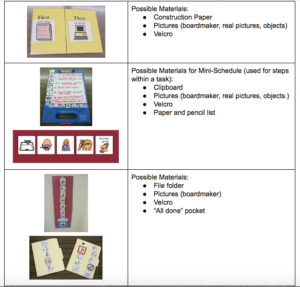Visual Schedules
What and Why:
One component of structuring an environment by telling a student what activities will occur and in what sequence. They assist with sequential memory, organization of time, language comprehension, decreasing anxiety levels, and helping a student transitioning independently.
Materials Needed:
- Materials will vary. Some examples include:
How and When to Implement:
- In developing a visual schedule, the following student questions need to be answered:
- What am I expected to do?
- How much am I expected to do?
- How will I know when I am finished?
- Where do I put my finished work?
- What will I get when I’m done or what do I do next?
- This would be useful when a student needs support with completing daily routines.
- Implement throughout the day to provide visual support of a student’s routine.
- Teach/model using the visual support when first introduced.
- When coaching or prompting, point to individual visuals using limited verbal information.
- The goal is to extinguish pointing and verbal so that the student is able to use the visual support independently.
Things to Consider/Problem Solving:
- Think about the number of icons displayed at one time.
- Think about if the visuals will be real objects, real pictures, symbols, or words.
- Think about creating mini-schedules to break down steps within a task.
- When a student is responding, continue utilizing this support and keep visuals in place even when a student has memorized their schedule/routine. The team may want to consider moving towards a more student directed or age appropriate visual support (e.g. calendar on iphone).
Useful Resources to Learn More:
http://www.specialed.us/autism/structure/str11.htm
http://www.pbisworld.com/tier-2/individual-visual-schedules/
Click to return to Best Practices for Supporting Students with Autism
Information compiled by Lincoln Public Schools Autism Team (September 2015)


